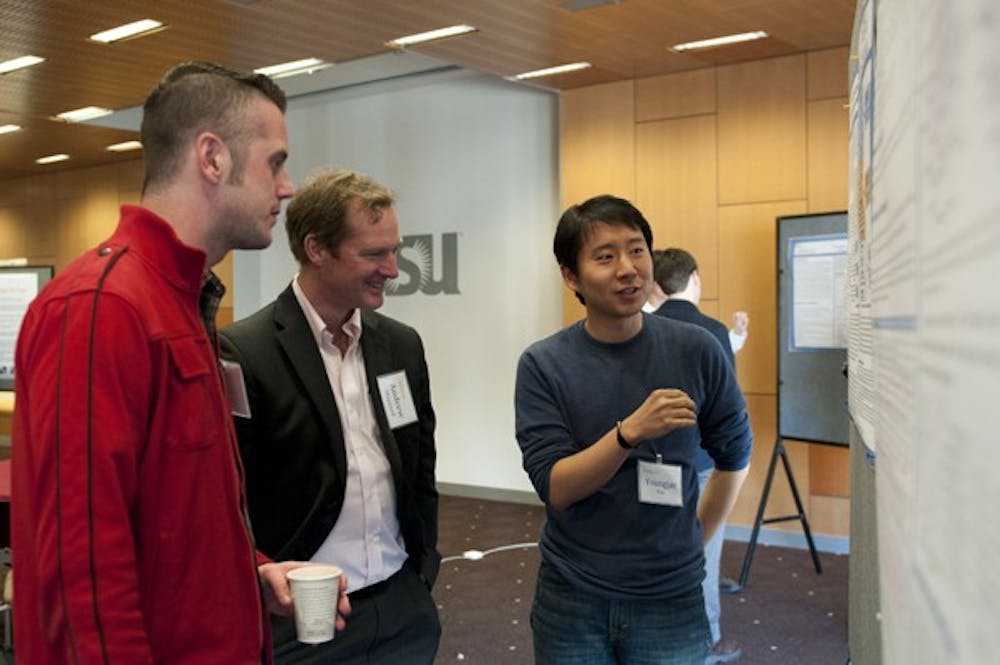 Graduate student Youngjae Kim (right) presents his research project on the current status and future direction for nanotechnology regulations to graduate student Jathan Sadowski (left) and Andrew Maynard (center) with the board for the Center for Nanotechnology in Society at ASU. Several graduate students met at the Memorial Union on Friday to present their projects to members of the board. (Photo by Molly J Smith)
Graduate student Youngjae Kim (right) presents his research project on the current status and future direction for nanotechnology regulations to graduate student Jathan Sadowski (left) and Andrew Maynard (center) with the board for the Center for Nanotechnology in Society at ASU. Several graduate students met at the Memorial Union on Friday to present their projects to members of the board. (Photo by Molly J Smith)
Graduate students strive to understand the small at the Center of Nanotechnology in Society.
Director David Guston explained the federal definition of nanotechnology as the control of matter at the nanoscale, or between 1 and 100 nanometers.
“It’s the science of the very, very ... very small,” Guston said.
Nanotechnology also involves the study of a matter’s unique properties at the nanoscale.
Gold, for example, is inactive in its normal state.
“At the nanoscale level, gold is highly reactive, and people use it to connect molecules together,” Guston said.
Guston said the Center for Nanotechnology in Society was founded by a National Science Foundation grant in October 2005. Along with another center at the University of California, Santa Barbara, it focuses research on nanotechnology and the social aspects behind it.
The core of the ASU branch is on the Tempe campus, with collaborators at Georgia Tech University and the University of Wisconsin-Madison. The center's total staff across the three campuses consists of nearly 50 people.
Meetings are essential to keeping up on the center’s research, Guston said.
“A lot of it is sharing info and updates going on in the center,” he said.
The center favors face-to-face interaction over impersonal communication through email or telephone calls.
Assistant Director Regina Sanborn said students and faculty have worked with the School of Sustainability to look at nanotechnology’s uses in a city and with the Sandra Day O’Connor College of Law on governing the emerging technologies.
Sanborn said the most rewarding part of her work is watching these students graduate.
“It’s almost like being a parent and watching your children graduate,” she said.
Sustainable engineering graduate student Benjamin Wender considers his engineering innovations from technical and social standpoints.
“I create new knowledge and new perspectives on things,” he said.
Wender assesses social and environmental impacts across the life cycle of nanotechnologies, from mining of resources to its end via disposal or recycling.
“I want to do research and continue nanotechnology development towards environmental improvement,” he said.
Public policy graduate student Sanjay Arora is not an ASU student, but a visiting student from the Georgia Institute of Technology.
He works in real-time technology assessment to mine data and analyze the rise of nanotechnology, including the increase of scientific terms using the prefix "nano-."
Aside from research and publication, Arora said he derives the most reward from meeting new people.
“The most random kind of encounter will produce a whole new line of research for you,” he said.
Board of Visitors' member Colin Milburn’s duty is to advise and review the activities of students and researchers involved and give feedback on successes.
“They represent an intersection of disciplines between social sciences and humanities essential to understanding the effects of new technology in society,” he said.
Milburn said the interdisciplinary methods students learn at the center foster understanding of new and future social and technological challenges. He said he learned many different aspects he was not familiar with as a researcher.
Through his own questions and feedback, Milburn hopes to give students further insight into their own work.
"I also want to express mygenuine enthusiasm for the work they are doing," he added in an email.
Reach the reporter at smande17@asu.edu or follow her on Twitter @SarahDeAnderson




